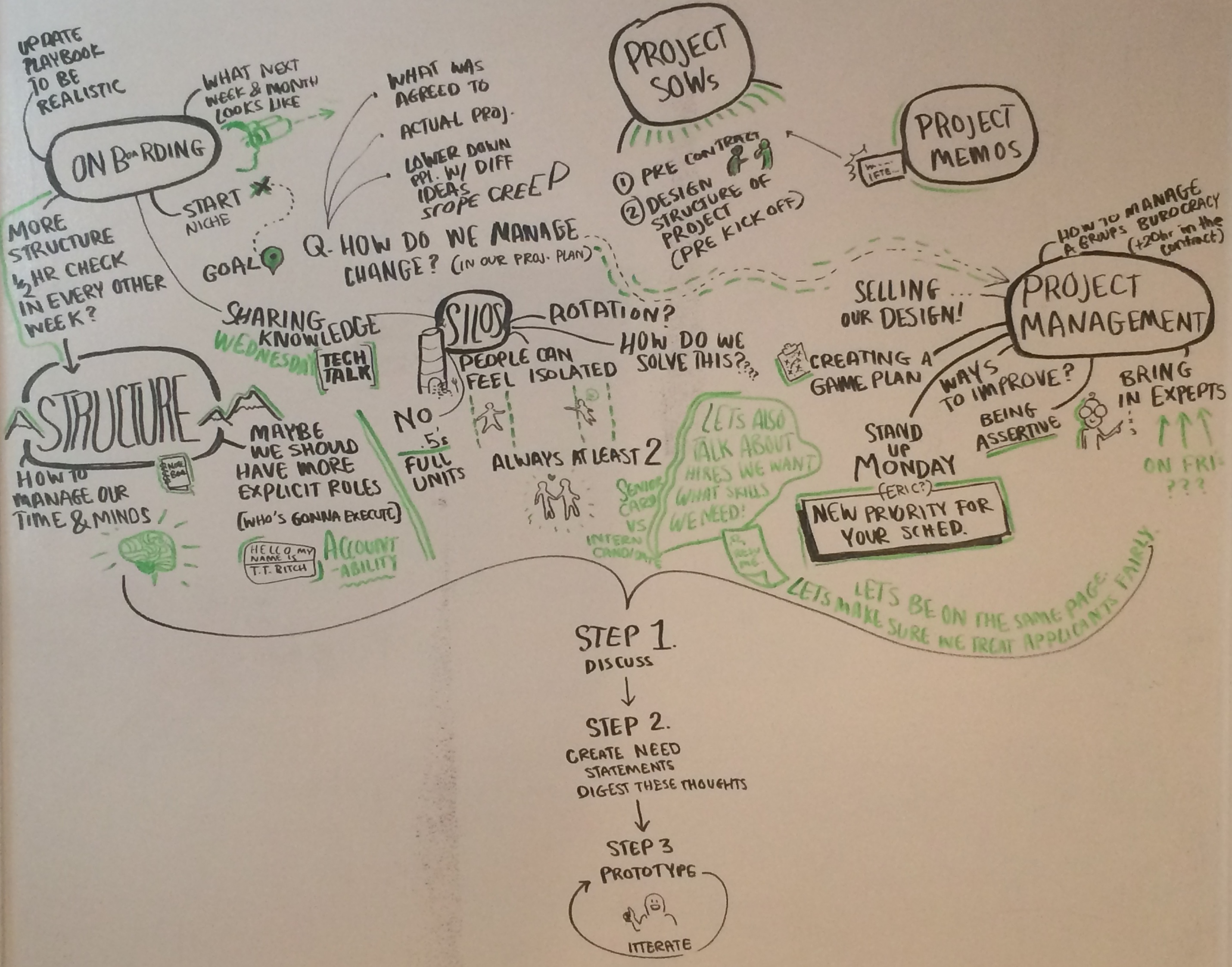Foundation
This is the GoInvo Playbook.
It’s the gold source reference for learning how to run a project, operate the studio, and why we design.
Read it.
Update it.
Share it.
(Yes, it’s open source, licensed under Apache 2.0, and available for the planet to use.)
If this is your first day, get started with our Day 1 Checklist.
Don’t memorize this.
These checklists and how-tos are always in your pocket.
Or bring a shrubbery, not too big or expensive, and print the whole thing.
The Imperfect Guide to GoInvo Citizenship
We are designers and engineers.
We design and ship products and systems.
We regularly deliver.
And repeated success needs to be... repeatable.
Follow the process.
Most of the time (80%).
When you deviate (the other 20%),
measure the new path’s effectiveness.
Your input into this guide is vital.
Our evolution as a studio depends on it.
Otherwise, our practice becomes stale and limps toward death.
If you see something funky, fix it.
(Any edit follows our GitHub repo checklist.)
When you edit:
Be concise.
Show don’t tell.
Mobile first design.
It is possible TODAY (ie don’t wait for Godot).

Code of Ethics
Speak the Truth.
We tell the truth to others, with the intention of trying to do the most possible good.
Make the World Useful, Beautiful and Delightful.
We exercise the discipline required to produce ideas and things that are useful and beautiful in the world.
Learn, Share & Build.
We are curious, open creators who welcome new ideas and the input of others.
Be Vigilant.
Identify and respond to inequality, protecting and serving the ideas, communities, and people in our world.
Go Like Hell.
We are driven and committed to what we do, putting in extra effort in our quest for exceptional results.
Tangible Targets
Studio citizenship is founded in the Code of Ethics and is expressed through these actions (and many more). These are the practical asks that we have for you; learn, use, and evolve these tenets.
1. Work
Provide remarkable service to your customer and your team.
Meet your deadlines. Keep your promises. Respond to client communication within 2 business hours. Your clients should never be treated as uneducated patrons. They’re usually smarter than us.
Focus your focus.
Sharpshoot and prioritize! Don’t divide your attention between too many things, you lose focus and direction.
Know your numbers.
Know the cost of projects and the studio operation, track your time, and make informed decisions.
Don’t stop moving.
Don’t just talk about ideas in generalities. Even exploratory conversations should end with concrete next steps. The amount of energy to keep something moving is far less than the amount of energy to get something off the ground. However, if it isn’t to be, be humane and kill it quickly.
Take small bets.
Risks are a form of experimentation. Test your idea and study the results. What worked? What didn’t? Repair it, refine it, and then try again. The more tests you do, the more material you have to work with and the better your chances are for success. Implement your experiments in the real world.
2. Culture
Staff as entrepreneurs.
Take an ownership mindset. Lead. Set goals. Cultivate side projects. Challenge yourself — if you’re not challenged you’re not growing. Propel the studio mission — always keep the big picture in mind and look for opportunities to make the studio better.
Everything is a design project.
Communicating with your client is an opportunity for design; think about how you interact with clients, why you are doing it, and the potential impact. The studio is an experiment! Be a part of its evolution.
A policy of openness.
We believe that making all aspects of our business open promotes trust and better decision making among our staff. At the studio, transparent data means you have the power to participate in the studio’s direction. With clients, open information leads to trust and stronger relationships. Supporting and creating opensource software democratizes the creative process and eliminates barriers to innovative content. Be open and share with others — it’s how we all grow stronger collectively.
Publish or perish.
Print out your work. The physicality of having your work in the real world, instead of just living on your computer, allows you to see your designs more clearly and track the maturity of your creative process. Make it as accessible as possible! Open up for others to see and absorb their feedback. Revel in the free advice and ad hoc collaboration that comes with visibility.
3. Growth
Build and evolve your skills.
Try new things. Accumulating a variety of skills adds to your creative arsenal, enables you to collaborate effectively with others, and helps you become a more well-rounded individual. Don’t be afraid to ask for help when you need it.
Find a mentor, be a mentor.
Pair coding, pair designing, and group critiques increase the flow and exchange of ideas, amplify the quality of our output, and raise everyone’s design IQ. Give a tech talk, create artifacts, and share your knowledge.
Actively develop your own vision.
Find the work that you are meant to do. Don’t accept Spaceship Earth as is — it needs your activism, ideas, and vigilance.
Bring in new work and new talent.
Find or create at least one job opportunity a year. Help hire others who are better than you.
Be afraid, just a little.
New paths can be daunting, but that’s where discovery and excitement are born.
Looking for more? Check out this checklist for Invo-lightenment.